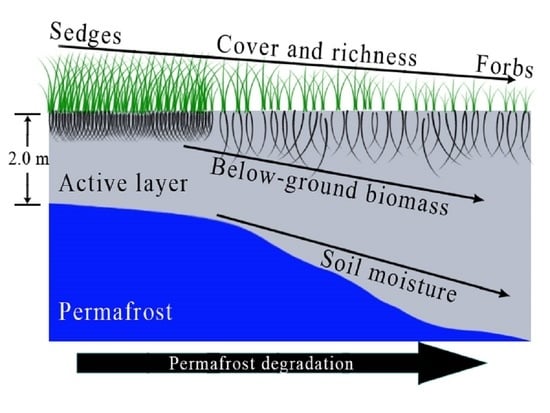Permafrost Degradation Leads to Biomass and Species Richness Decreases on the Northeastern Qinghai-Tibet Plateau
Abstract
1. Introduction
2. Materials and Methods
2.1. Study Area
2.2. Field Work and Laboratory Analyses
2.3. Data Analysis Methods
3. Results
3.1. Characteristics of Environmental Factors in Areas of Permafrost and Seasonally Frozen Ground
3.2. Characteristics of Vegetation in Areas of Permafrost and Seasonally Frozen Ground
3.3. Distribution of Vegetation and Soil Properties along the ALT Gradient
3.4. Relationship between Vegetation and Environmental Factors
4. Discussion
4.1. Changes in Vegetation Characteristics with the ALT
4.2. Influencing Factors of Vegetation in Response to Permafrost Degradation
5. Conclusions
Author Contributions
Funding
Acknowledgments
Conflicts of Interest
References
- IPCC. Climate Change: Synthesis report. Contribution of Working Groups I, II and III to the Fifth Assessment Report of the Intergovernmental Panel on Climate Change; Pachauri, R.K., Meyer, L.A., Eds.; IPCC: Geneva, Switzerland, 2014. [Google Scholar]
- Biskaborn, B.K.; Smith, S.L.; Noetzli, J.; Matthes, H.; Vieira, G.; Streletskiy, D.A.; Schoeneich, P.; Romanovsky, V.E.; Lewkowicz, A.G.; Abramov, A. Permafrost is warming at a global scale. Nat. Commun. 2019, 10, 264. [Google Scholar] [CrossRef] [PubMed]
- Osterkamp, T.E. Characteristics of the recent warming of permafrost in Alaska. J. Geophys. Res. Earth Surf. 2007, 112, F02S02. [Google Scholar] [CrossRef]
- Åkerman, H.J.; Johansson, M. Thawing permafrost and thicker active layers in sub-arctic Sweden. Permafr. Periglac. Process. 2008, 19, 279–292. [Google Scholar] [CrossRef]
- Jin, H.J.; He, R.X.; Cheng, G.D.; Wu, Q.B.; Wang, S.L.; Lu, L.Z.; Chang, X.L. Changes in frozen ground in the Source Area of the Yellow River on the Qinghai-Tibet Plateau, China, and their eco-environmental impacts. Environ. Res. Lett. 2009, 4, 045206. [Google Scholar] [CrossRef]
- Jin, H.J.; Luo, D.L.; Wang, S.L.; Lü, L.Z.; Wu, J.C. Spatiotemporal variability of permafrost degradation on the Qinghai-Tibet Plateau. Sci. Cold Arid Reg. 2011, 3, 281–305. [Google Scholar]
- Qin, Y.H.; Liu, W.F.; Guo, Z.H.; Xue, S.B. Spatial and temporal variations in soil temperatures over the Qinghai–Tibet Plateau from 1980 to 2017 based on reanalysis products. Theor. Appl. Climatol. 2020, 140, 1055–1069. [Google Scholar] [CrossRef]
- Hinkel, K.M.; Paetzold, F.; Nelson, F.E.; Bockheim, J.G. Patterns of soil temperature and moisture in the active layer and upper permafrost at Barrow, Alaska: 1993–1999. Glob. Planet. Chang. 2001, 29, 293–309. [Google Scholar] [CrossRef]
- Wu, Q.B.; Zhang, T.J. Changes in active layer thickness over the Qinghai-Tibetan Plateau from 1995 to 2007. J. Geophys. Res. Atmos. 2010, 115, D09107. [Google Scholar] [CrossRef]
- Vasiliev, A.A.; Drozdov, D.S.; Gravis, A.G.; Malkova, G.V.; Nyland, K.E.; Streletskiy, D.A. Permafrost degradation in the Western Russian Arctic. Environ. Res. Lett. 2020, 15, 045001. [Google Scholar] [CrossRef]
- Zhao, L.; Zou, D.F.; Hu, G.J.; Du, E.J.; Pang, Q.Q.; Xiao, Y.; Li, R.; Sheng, Y.; Wu, X.D.; Sun, Z. Changing climate and the permafrost environment on the Qinghai-Tibet (Xizang) plateau. Permafr. Periglac. Process 2020. [Google Scholar] [CrossRef]
- Yi, S.H.; Zhou, Z.Y.; Ren, S.L.; Xu, M.; Qin, Y.; Chen, S.Y.; Ye, B.S. Effects of permafrost degradation on alpine grassland in a semi-arid basin on the Qinghai-Tibetan Plateau. Environ. Res. Lett. 2011, 6, 045403. [Google Scholar] [CrossRef]
- Iturrate-Garcia, M.; O’Brien, M.J.; Khitun, O.; Abiven, S.; Niklaus, P.A.; Schaepman-Strub, G. Interactive effects between plant functional types and soil factors on tundra species diversity and community composition. Ecol. Evol. 2016, 6, 8126–8137. [Google Scholar] [CrossRef] [PubMed]
- Mu, C.C.; Li, L.L.; Zhang, F.; Li, Y.X.; Xiao, X.X.; Zhao, Q.; Zhang, T.J. Impacts of permafrost on above- and belowground biomass on the northern Qinghai-Tibetan Plateau. Arct. Antarct. Alp. Res. 2018, 50, e1447192. [Google Scholar] [CrossRef]
- Terskaia, A.; Dial, R.J.; Sullivan, P.F. Pathways of tundra encroachment by trees and tall shrubs in the western Brooks Range of Alaska. Ecography 2020, 43, 769–778. [Google Scholar] [CrossRef]
- Finger, R.A.; Turetsky, M.R.; Kielland, K.; Ruess, R.W.; Mack, M.C.; Euskirchen, E.S. Effects of permafrost thaw on nitrogen availability and plant-soil interactions in a boreal Alaskan lowland. J. Ecol. 2016, 104, 1542–1554. [Google Scholar] [CrossRef]
- Jorgenson, M.T.; Racine, C.H.; Walters, J.C.; Osterkamp, T.E. Permafrost degradation and ecological changes associated with a warming climate in central Alaska. Clim. Chang. 2001, 48, 551–579. [Google Scholar] [CrossRef]
- Sistla, S.A.; Moore, J.C.; Simpson, R.T.; Gough, L.; Shaver, G.R.; Schimel, J.P. Long-term warming restructures Arctic tundra without changing net soil carbon storage. Nature 2013, 497, 615–618. [Google Scholar] [CrossRef]
- Ravolainen, V.; Soininen, E.M.; Jonsdottir, I.S.; Eischeid, I.; Forchhammer, M.; van der Wal, R.; Pedersen, A.O. High Arctic ecosystem states: Conceptual models of vegetation change to guide long-term monitoring and research. Ambio 2020, 49, 666–677. [Google Scholar] [CrossRef]
- Frost, G.V.; Epstein, H.E.; Walker, D.A.; Matyshak, G.; Ermokhina, K. Seasonal and Long-Term Changes to Active-Layer Temperatures after Tall Shrubland Expansion and Succession in Arctic Tundra. Ecosystems 2018, 21, 507–520. [Google Scholar] [CrossRef]
- Yang, Z.; Gao, J.; Zhao, L.; Xu, X.; Ouyang, H. Linking thaw depth with soil moisture and plant community composition: Effects of permafrost degradation on alpine ecosystems on the Qinghai-Tibet Plateau. Plant Soil 2013, 367, 687–700. [Google Scholar] [CrossRef]
- Wang, Z.R.; Yang, G.J.; Yi, S.H.; Wu, Z.; Guan, J.Y.; He, X.B.; Ye, B.S. Different response of vegetation to permafrost change in semi-arid and semi-humid regions in Qinghai–Tibetan Plateau. Environ. Earth Sci. 2012, 66, 985–991. [Google Scholar]
- Walker, D.A.; Jia, G.J.; Epstein, H.E.; Raynolds, M.K.; Chapin, F.S.; Copass, C.; Hinzman, L.D.; Knudson, J.A.; Maier, H.A.; Michaelson, G.J. Vegetation-soil-thaw-depth relationships along a Low-Arctic bioclimate gradient, Alaska: Synthesis of information from the ATLAS studies. Permafr. Periglac. Process. 2003, 14, 103–123. [Google Scholar] [CrossRef]
- Runyan, C.W.; D’Odorico, P. Ecohydrological feedbacks between permafrost and vegetation dynamics. Adv. Water Resour. 2012, 49, 1–12. [Google Scholar] [CrossRef]
- Luo, D.L.; Liu, L.; Jin, H.J.; Wang, X.F.; Chen, F.F. Characteristics of ground surface temperature at Chalaping in the Source Area of the Yellow River, northeastern Tibetan Plateau. Agric. For. Meteorol. 2020, 284, 107888. [Google Scholar] [CrossRef]
- Vonk, J.E.; Tank, S.E.; Bowden, W.B.; Laurion, I.; Vincent, W.F.; Alekseychik, P.; Amyot, M.; Billet, M.F.; Canario, J.; Cory, R.M. Reviews and syntheses: Effects of permafrost thaw on Arctic aquatic ecosystems. Biogeosciences 2015, 12, 7129–7167. [Google Scholar] [CrossRef]
- Wang, G.X.; Li, Y.S.; Wu, Q.B.; Wang, Y.B. Impacts of permafrost changes on alpine ecosystem in Qinghai-Tibet Plateau. Sci. China Ser. D-Earth Sci. 2006, 49, 1156–1169. [Google Scholar] [CrossRef]
- Jin, X.Y.; Jin, H.J.; Iwahana, G.; Marchenko, S.S.; Luo, D.L.; Li, X.Y.; Liang, S.H. Impacts of climate-induced permafrost degradation on vegetation: A review. Adv. Clim. Chang. Res. 2020. [Google Scholar] [CrossRef]
- Luo, D.L.; Jin, H.J.; Wu, Q.B.; Bense, V.F.; He, R.X.; Ma, Q.; Gao, S.H.; Jin, X.Y.; Lü, L.Z. Thermal regime of warm-dry permafrost in relation to ground surface temperature in the Source Areas of the Yangtze and Yellow rivers on the Qinghai-Tibet Plateau, SW China. Sci. Total Environ. 2018, 618, 1033–1045. [Google Scholar] [CrossRef]
- Tian, H.; Lan, Y.; Wen, J.; Jin, H.; Wang, C.; Wang, X.; Kang, Y. Evidence for a recent warming and wetting in the source area of the Yellow River (SAYR) and its hydrological impacts. J. Geogr. Sci. 2015, 25, 643–668. [Google Scholar] [CrossRef]
- Luo, D.L.; Jin, H.J.; He, R.X.; Wang, X.F.; Muskett, R.R.; Marchenko, S.S.; Romanovsky, V.E. Characteristics of Water-Heat Exchanges and Inconsistent Surface Temperature Changes at an Elevational Permafrost Site on the Qinghai-Tibet Plateau. J. Geophys. Res. Atmos. 2018, 123, 10404–10422. [Google Scholar] [CrossRef]
- Luo, D.L.; Jin, H.J.; Jin, X.Y.; He, R.X.; Li, X.Y.; Muskett, R.R.; Marchenko, S.S.; Romanovsky, V.E. Elevation-dependent thermal regime and dynamics of frozen ground in the Bayan Har Mountains, northeastern Qinghai-Tibet Plateau, southwest China. Permafr. Periglac. Process. 2018, 29, 257–270. [Google Scholar] [CrossRef]
- Lin, L.; Jin, H.J.; Luo, D.L.; Lü, L.Z.; He, R.X. Preliminary study on major features of alpine vegetation in the Source Area of the Yellow River (SAYR). J. Glaciol. Geocryol. 2014, 36, 230–236, (In Chinese with English Abstract). [Google Scholar]
- Li, J.; Sheng, Y.; Wu, J.; Feng, Z.; Ning, Z.; Hu, X.; Zhang, X. Landform-related permafrost characteristics in the source area of the Yellow River, eastern Qinghai-Tibet Plateau. Geomorphology 2016, 269, 104–111. [Google Scholar] [CrossRef]
- Luo, D.L.; Jin, H.J.; Marchenko, S.; Romanovsky, V.E. Distribution and changes of active layer thickness (ALT) and soil temperature (TTOP) in the source area of the Yellow River using the GIPL model. Sci. Total Environ. 2014, 57, 1834–1845. [Google Scholar] [CrossRef]
- Chang, D.H.S. The vegetation zonation of the Tibetan Plateau. Mt. Res. Dev. 1981, 1, 29–48. [Google Scholar] [CrossRef]
- Yu, G.; Brierley, G.; Huang, H.Q.; Wang, Z.; Blue, B.; Ma, Y. An environmental gradient of vegetative controls upon channel planform in the source region of the Yangtze and Yellow Rivers. Catena 2014, 119, 143–153. [Google Scholar] [CrossRef]
- Niu, Y.J.; Yang, S.W.; Zhou, J.W.; Chu, B.; Zhu, H.M.; Hua, L.M. Vegetation distribution along mountain environmental gradient predicts shifts in plant community response to climate change in alpine meadow on the Tibetan Plateau. Sci. Total Environ. 2019, 650, 505–514. [Google Scholar] [CrossRef]
- Yang, Y.S.; Zhang, L.; Li, H.Q.; He, H.D.; Wei, Y.X.; Luo, J.; Zhang, G.R.; Huang, Y.R.; Li, Y.N.; Zhou, H.K. Soil physicochemical properties and vegetation structure along an elevation gradient and implications for the response of alpine plant development to climate change on the northern slopes of the Qilian Mountains. J. Mt. Sci. 2018, 15, 1006–1019. [Google Scholar] [CrossRef]
- Wilsey, B.J.; Potvin, C. Biodiversity and ecosystem functioning: Importance of species evenness in an old field. Ecology 2000, 81, 887–892. [Google Scholar] [CrossRef]
- Van der Walt, L.; Cilliers, S.S.; Du Toit, M.J.; Kellner, K. Conservation of fragmented grasslands as part of the urban green infrastructure: How important are species diversity, functional diversity and landscape functionality? Urban Ecosyst. 2015, 18, 87–113. [Google Scholar] [CrossRef]
- Dufrene, M.; Legendre, P. Species assemblages and indicator species: The need for a flexible asymmetrical approach. Ecol. Monogr. 1997, 67, 345–366. [Google Scholar] [CrossRef]
- Kruskal, J.B. Nonmetric multidimensional scaling: A numerical method. Psychometrika 1964, 29, 115–129. [Google Scholar] [CrossRef]
- Bray, J.R.; Curtis, J.T. An ordination of the upland forest communities of southern Wisconsin. Ecol. Monogr. 1957, 27, 325–349. [Google Scholar] [CrossRef]
- Oksanen, J.; Blanchet, F.G.; Kindt, R.; Legendre, P.; Minchin, P.R.; O’Hara, R.B.; Simpson, G.L.; Solymos, P.; Stevens, M.H.H.; Szoecs, E.; et al. vegan: Community Ecology Package; Comprehensive R Archive Network: Los Angeles, CA, USA, 2013. [Google Scholar]
- Dixon, P. VEGAN, a package of R function for community ecology. J. Veg. Sci. 2003, 14, 927–930. [Google Scholar] [CrossRef]
- R Core Team. R: A Language and Environment for Statistical Computing; R Foundation for Statistical Computing: Vienna, Austria, 2019; Available online: https://www.R.-profect.org/ (accessed on 23 October 2020).
- Luo, D.; Jin, H.J.; Bense, V.F. Ground surface temperature and the detection of permafrost in the rugged topography on NE Qinghai-Tibet Plateau. Geoderma 2019, 333, 57–68. [Google Scholar] [CrossRef]
- Chen, R.H.; Tabatabaeenejad, A.; Moghaddam, M. Retrieval of Permafrost Active Layer Properties Using Time-Series P-Band Radar Observations. IEEE Trans. Geosci. Remote Sens. 2019, 57, 6037–6054. [Google Scholar] [CrossRef]
- Hrbacek, F.; Cannone, N.; Knazkova, M.; Malfasi, F.; Convey, P.; Guglielmin, M. Effect of climate and moss vegetation on ground surface temperature and the active layer among different biogeographical regions in Antarctica. Catena 2020, 190, 104562. [Google Scholar] [CrossRef]
- Schuur, E.A.G.; Mack, M.C. Ecological response to permafrost thaw and consequences for local and global ecosystem services. Annu. Rev. Ecol. Evol. Syst. 2018, 49, 279–301. [Google Scholar] [CrossRef]
- Baltzer, J.L.; Veness, T.; Chasmer, L.E.; Sniderhan, A.E.; Quinton, W.L. Forests on thawing permafrost: Fragmentation, edge effects, and net forest loss. Glob. Chang. Biol. 2014, 20, 824–834. [Google Scholar] [CrossRef]
- Jorgenson, M.T.; Frost, G.V.; Dissing, D. Drivers of landscape changes in coastal ecosystems on the Yukon-Kuskokwim Delta, Alaska. Remote Sens. 2018, 10, 1280. [Google Scholar] [CrossRef]
- Anderson, J.E.; Douglas, T.A.; Barbato, R.A.; Saari, S.; Edwards, J.D.; Jones, R.M. Linking vegetation cover and seasonal thaw depths in interior Alaska permafrost terrains using remote sensing. Remote Sens. Environ. 2019, 233, 111363. [Google Scholar] [CrossRef]
- Christensen, T.R.; Johansson, T.R.; Akerman, H.J.; Mastepanov, M.; Malmer, N.; Friborg, T.; Crill, P.; Svensson, B.H. Thawing sub-arctic permafrost: Effects on vegetation and methane emissions. Geophys. Res. Lett. 2004, 31, L04501. [Google Scholar] [CrossRef]
- Li, C.Y.; Peng, F.; Xue, X.; You, Q.G.; Lai, C.M.; Zhang, W.J.; Cheng, Y.X. Productivity and quality of alpine grassland vary with soil water availability under experimental warming. Front. Plant Sci. 2018, 9, 1790. [Google Scholar] [CrossRef] [PubMed]
- Yao, X.X.; Wu, J.P.; Gong, X.Y.; Lang, X.; Wang, C.L.; Song, S.Z.; Ahmad, A.A. Effects of long term fencing on biomass, coverage, density, biodiversity and nutritional values of vegetation community in an alpine meadow of the Qinghai-Tibet Plateau. Ecol. Eng. 2019, 130, 80–93. [Google Scholar] [CrossRef]
- Chen, S.Y.; Liu, W.J.; Qin, X.; Liu, Y.S.; Zhang, T.Z.; Chen, K.L.; Hu, F.Z.; Ren, J.W.; Qin, D.H. Response characteristics of vegetation and soil environment to permafrost degradation in the upstream regions of the Shule River Basin. Environ. Res. Lett. 2012, 7, 045406. [Google Scholar] [CrossRef]
- Wang, Y.B.; Wang, G.X.; Zhang, C.M.; Long, X.J. Response of soil physicochemical properties to the changes of the vegetation ecosystem on the Tibetan Plateau. J. Glaciol. Geocryol. 2007, 29, 921–927, (In Chinese with English Abstract). [Google Scholar]
- Ma, Q.F.; Cui, L.J.; Song, H.T.; Gao, C.J.; Hao, Y.Q.; Luan, J.W.; Wang, Y.F.; Li, W. Aboveground and Belowground Biomass Relationships in the Zoige Peatland, Eastern Qinghai-Tibetan Plateau. Wetlands 2017, 37, 461–469. [Google Scholar] [CrossRef]
- Li, H.L.; Nicotra, A.B.; Xu, D.H.; Du, G.Z. Habitat-specific responses of leaf traits to soil water conditions in species from a novel alpine swamp meadow community. Conserv. Physiol. 2015, 3, cov046. [Google Scholar] [CrossRef]
- Yang, Y.; Wang, G.X.; Klanderud, K.; Wang, J.F.; Liu, G.S. Plant community responses to five years of simulated climate warming in an alpine fen of the Qinghai-Tibetan Plateau. Plant Ecol. Divers. 2015, 8, 211–218. [Google Scholar] [CrossRef]
- Ganjurjav, H.; Gornish, E.S.; Hu, G.Z.; Wan, Y.F.; Li, Y.; Danjiu, L.B.; Gao, Q.Z. Temperature leads to annual changes of plant community composition in alpine grasslands on the Qinghai-Tibetan Plateau. Environ. Monit. Assess. 2018, 190, 585. [Google Scholar] [CrossRef]
- Nabe-Nielsen, J.; Normand, S.; Hui, F.K.C.; Stewart, L.; Bay, C.; Nabe-Nielsen, L.I.; Schmidt, N.M. Plant community composition and species richness in the High Arctic tundra: From the present to the future. Ecol. Evol. 2017, 7, 10233–10242. [Google Scholar] [CrossRef] [PubMed]
- Gao, Z.Y.; Lin, Z.J.; Niu, F.J.; Luo, J. Soil water dynamics in the active layers under different land-cover types in the permafrost regions of the Qinghai-Tibet Plateau, China. Geoderma 2020, 364, 114176. [Google Scholar] [CrossRef]
- Giaccone, E.; Luoto, M.; Vittoz, P.; Guisan, A.; Mariethoz, G.; Lambiel, C. nfluence of microclimate and geomorphological factors on alpine vegetation in the Western Swiss Alps. Earth Surf. Process. Landf. 2019, 44, 3093–3107. [Google Scholar] [CrossRef]
- Körner, C. Alpine plant life. In Functional Plant Ecology of High Mountain Ecosystems, 2nd ed.; Springer: Berlin/Heidelberg, Germany, 2003; p. 344. [Google Scholar]
- Wang, J.; Fu, B.J.; Qiu, Y.; Chen, L.D. Soil nutrients in relation to land use and landscape position in the semi-arid small catchment on the loess plateau in China. J. Arid. Environ. 2001, 48, 537–550. [Google Scholar] [CrossRef]
- Dessalegn, D.; Beyene, S.; Ram, N.; Walley, F.; Gala, T.S. Effects of topography and land use on soil characteristics along the toposequence of Ele watershed in southern Ethiopia. Catena 2013, 115, 47–54. [Google Scholar] [CrossRef]
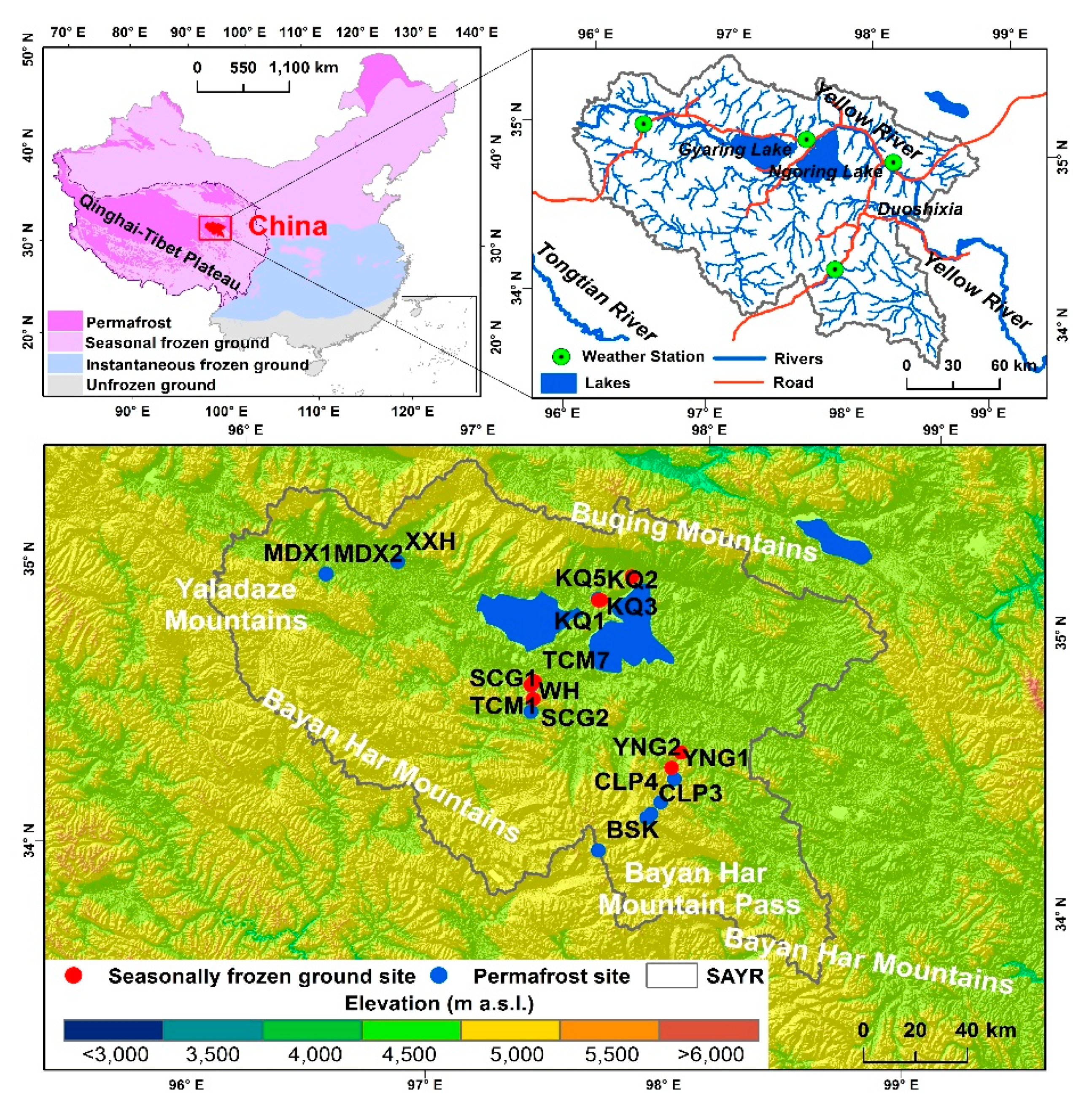

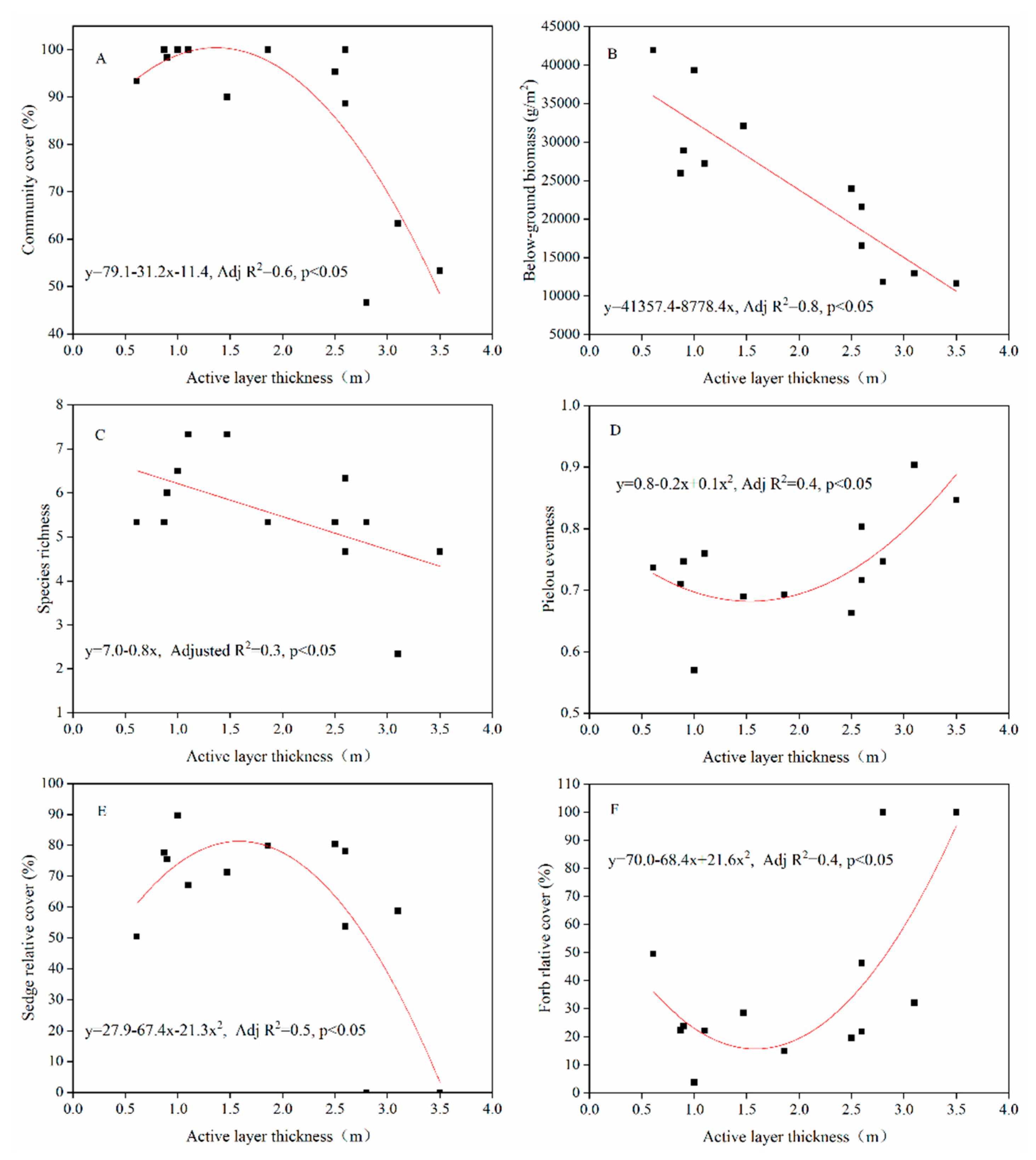

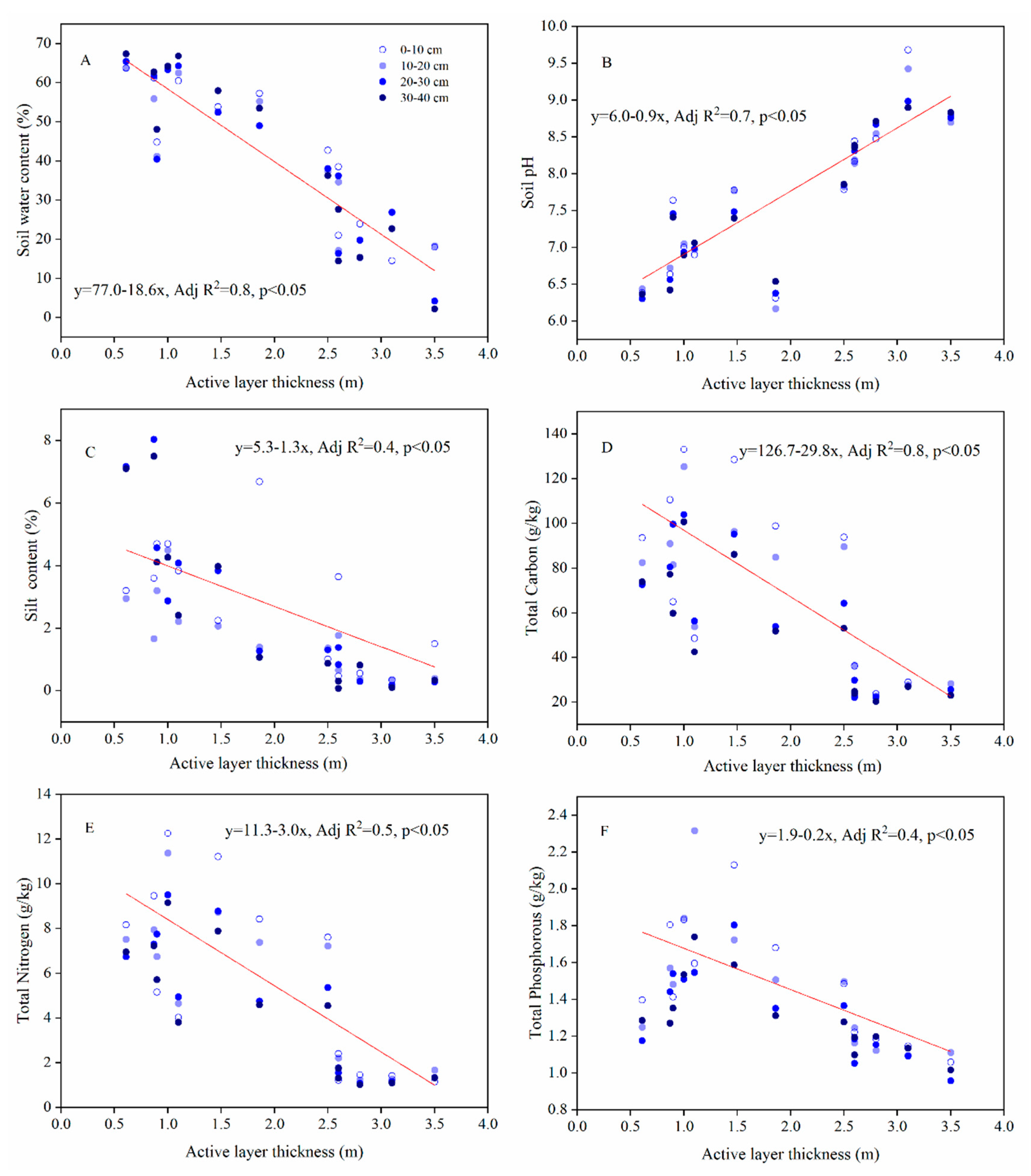
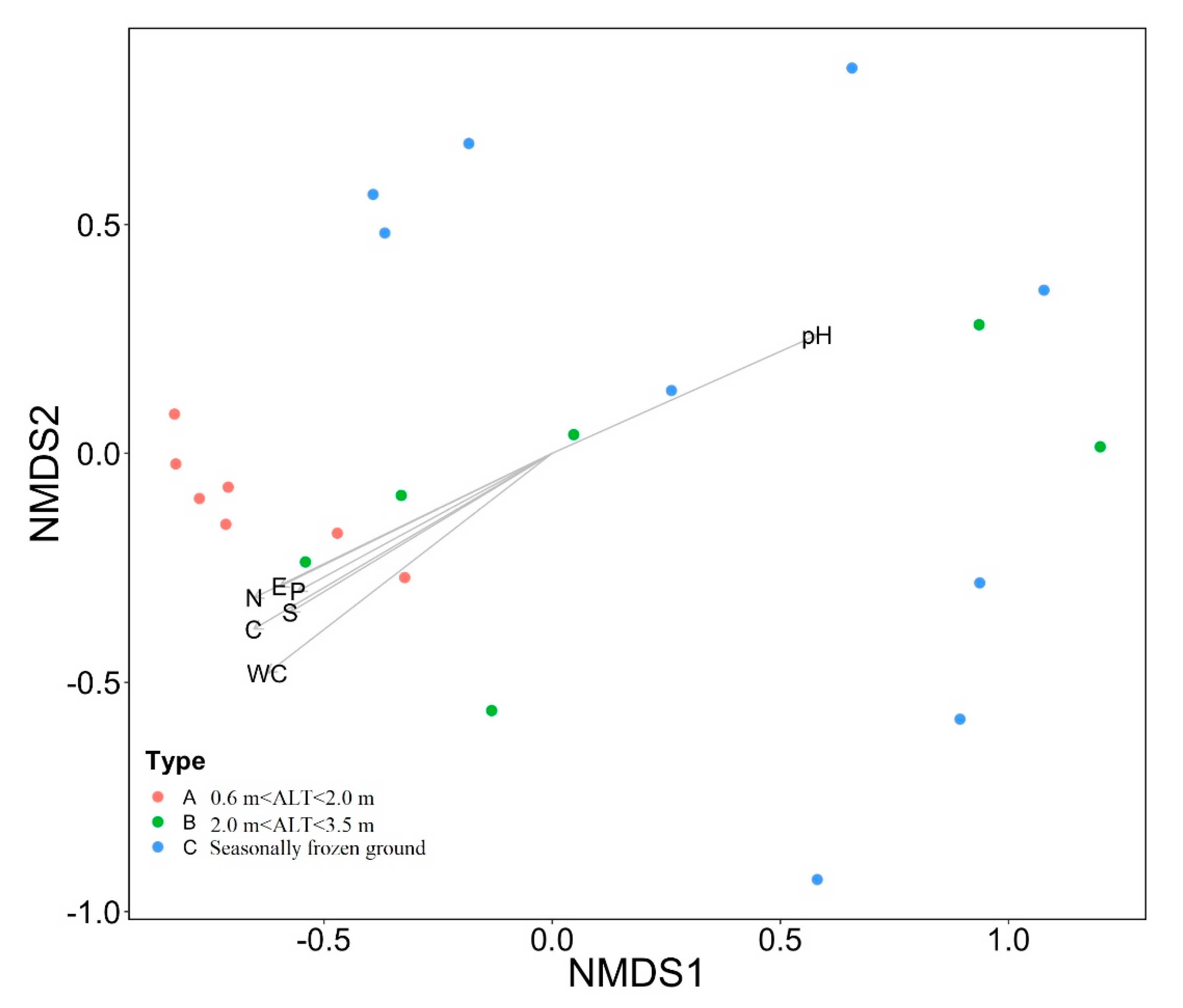
| Sites | Longitude (°E) | Latitude (°N) | ALT (m) | MAGT (°C) | Elevation (m a. s. l.) | Slope (°) | Aspect | Topography | Soil Texture | Vegetation |
|---|---|---|---|---|---|---|---|---|---|---|
| BSK | 97.6551 | 34.1287 | 0.61 | −1.6 | 4833 | 5 | west | Mountain pass | Fine sand | AM |
| CLP2 | 97.8496 | 34.2563 | 0.87 | −1.7 | 4727 | 0 | 0 | High flat plateau | Silt and loam | AM |
| TCM1 | 97.3141 | 34.6967 | 0.90 | −0.2 | 4340 | 2 | east-facing | Hill foot | Fine sand | AM |
| CLP4 | 97.9037 | 34.3148 | 1.00 | −0.6 | 4564 | 0 | 0 | In the valley | Fine sand | AM |
| SCG1 | 97.3269 | 34.6491 | 1.10 | −0.4 | 4411 | 3 | east-facing | Alluvial fan | Fine sand | AM |
| YNG1 | 97.9546 | 34.4013 | 1.47 | −0.1 | 4452 | 4 | east | Intramontane basin | Fine sand | AM |
| CLP3 | 97.8667 | 34.2706 | 1.86 | −1.1 | 4663 | 0 | 0 | mountain top | Fine sand with coarse gravels | AM |
| WL | 97.3220 | 34.6040 | 2.50 | N/A | 4427 | 9 | east | Lake bank | fine sand | AM |
| MDX1 | 96.3961 | 35.0367 | 2.60 | N/A | 4421 | 0 | 0 | basin | Fine sand with gravels | AM |
| MDX2 | 96.3950 | 35.0350 | 2.60 | N/A | 4423 | 0 | 0 | basin | Coarse sand with gravels | AM |
| KQ4 | 97.5708 | 35.0211 | 2.80 | −0.6 | 4291 | 5 | east | slope | Coarse sand with gravels | AD |
| KQ2 | 97.5734 | 35.0167 | 3.10 | −0.4 | 4294 | 0 | 0 | basin | Fine sand | AM |
| XXH | 96.6976 | 35.0999 | 3.50 | −0.2 | 4334 | 0 | 0 | Alluvial fan | Coarse sand with gravels | AS |
| SCG2 | 97.3278 | 34.6491 | N/A | N/A | 4405 | 4 | east | Alluvial fan | Fine sand with gravel | AS |
| TCM6 | 97.3248 | 34.7101 | N/A | N/A | 4311 | 0 | 0 | basin | Fine sand with gravels | AS |
| TCM4 | 97.3124 | 34.6986 | S | 1.4 | 4326 | 1 | south | basin | Coarse sand with gravels | AS |
| KQ1 | 97.5823 | 35.0175 | S | 1.0 | 4289 | 6 | 6/south | slope | Fine sand | AM |
| KQ3 | 97.5731 | 35.0166 | S | 0.4 | 4295 | 5 | 5/south | slope | Fine sand with gravels | AD |
| YNG3 | 97.9747 | 34.4962 | S | 1.1 | 4333 | 0 | 0 | Plain | Fine sand | AM |
| YNG2 | 97.9396 | 34.4403 | S | 1.2 | 4395 | 9 | 9/south | slope | Coarse sand with gravels | AS |
| TCM7 | 97.3258 | 34.7127 | S | 0.4 | 4310 | 1 | south | basin | Fine sand | AD |
| ELH | 97.7081 | 35.1102 | S | 1.5 | 4365 | 0 | 0 | Lake bank | Coarse sand with gravels | AS |
| Variables | Min | Max | Avg | SD |
|---|---|---|---|---|
| Active layer thickness (m) | 0.6 | 3.5 | 1.92 | 1.0 |
| Soil water content (%) | 11% | 65% | 35% | 18% |
| Elevation (m a. s. l.) | 4289 | 4833 | 4419 | 149 |
| Soil pH | 6 | 9 | 8 | 1 |
| Silt content (%) | 0.2% | 5.2% | 2.0% | 1.6% |
| Total carbon (g/kg) | 19.7 | 115.8 | 48.4 | 29.4 |
| Total nitrogen (g/kg) | 1.2 | 10.6 | 4.0 | 2.8 |
| Total phosphorous (g/kg) | 1.1 | 1.8 | 1.3 | 0.2 |
| Community cover (%) | 47% | 100% | 83% | 17% |
| Above-ground (g/m2) | 64.3 | 325.7 | 173.4 | 72.4 |
| Below-ground (g/m2) | 1163.4 | 41,966.0 | 20,791.4 | 9423.9 |
| Species richness | 2 | 9 | 6 | 2 |
| Pielou evenness index | 0.6 | 1 | 0.7 | 0.1 |
| Sedge relative cover (%) | 4% | 100% | 53% | 33% |
| Forb relative cover (%) | 0 | 90% | 44% | 32% |
| Vegetation Indices | Permafrost (Avg ± SD) | Seasonally Frozen Ground | p |
|---|---|---|---|
| Community cover (%) | 87 (±19) | 77 (±13) | >0.05 |
| Above-ground biomass (g/m2) | 156 (±84) | 199 (±43) | >0.05 |
| Below-ground biomass (g/m2) | 22,495 (±10,192) | 14,443 (±1230) | <0.01 |
| Species richness | 6 (±1) | 6(±2) | >0.05 |
| Pielou Evenness | 0.74 (±0.08) | 0.81 (±0.05) | >0.05 |
| Forb relative cover (%) | 37 (±30) | 75 (±23) | <0.05 |
| Sedge relative cover (%) | 60 (±29) | 21 (±20) | <0.05 |
| Environmental Factors | Community Cover (%) | Below-Ground Biomass (g/m2) | Pielou Evenness | Forb Relative Cover (%) | Sedge Relative Cover (%) |
|---|---|---|---|---|---|
| Soil water content (%) | 0.7 | 0.9 | −0.7 | −0.6 | 0.6 |
| Elevation (m a. l. s.) | 0.5 | 0.8 | −0.5 | −0.5 | 0.5 |
| Soil pH | −0.7 | −0.9 | 0.6 | 0.6 | −0.6 |
| Silt content (%) | 0.5 | 0.7 | −0.5 | 0.5 | |
| Total carbon (g/kg) | 0.6 | 0.9 | −0.7 | −0.7 | 0.7 |
| Total nitrogen (g/kg) | 0.6 | 0.9 | −0.7 | −0.6 | 0.6 |
| Total phosphorous (g/kg) | 0.7 | 0.7 | −0.6 | −0.7 | 0.6 |
| Soil Water Content (%) | Elevation (m a. s. l.) | pH | Silt Content (%) | Total Carbon (g/kg) | Total Nitrogen (g/kg) | Total Phosphorous (g/kg) | |
|---|---|---|---|---|---|---|---|
| Soil water content (%) | 1 | ||||||
| Elevation (m a. s. l.) | 0.8 ** | 1 | |||||
| pH | −0.9 ** | −0.8 ** | 1 | ||||
| Silt content (%) | 0.8 ** | 0.7 ** | −0.8 ** | 1 | |||
| Total carbon (g/kg) | 0.9 ** | 0.7 ** | −0.8 ** | 0.8 ** | 1 | ||
| Total nitrogen (g/kg) | 0.9 ** | 0.7 ** | −0.8 ** | 0.8 ** | 1 ** | 1 | |
| Total phosphorous (g/kg) | 0.9 ** | 0.4 | −0.7 ** | 0.6 ** | 0.8 ** | 0.8 ** | 1 |
| Variables | Regression Models | Radj2 | p |
|---|---|---|---|
| Community cover (%) | y = 64.1 + 55.9 WC (30–40 cm) | 0.4 | <0.01 |
| Below-ground biomass (g/m2) | y = 7860.4 + 39149.0 WC (30–40 cm) | 0.8 | <0.01 |
| Pielou evenness index | y = 0.9-0.4 WC (0–10 cm) | 0.5 | <0.01 |
| Sedge relative cover (%) | y = 10.9 + 98.4 WC (30–40 cm) | 0.4 | <0.01 |
| Forb relative cover (%) | y = 88.4–105.4 WC (30–40 cm) | 0.4 | <0.01 |
Publisher’s Note: MDPI stays neutral with regard to jurisdictional claims in published maps and institutional affiliations. |
© 2020 by the authors. Licensee MDPI, Basel, Switzerland. This article is an open access article distributed under the terms and conditions of the Creative Commons Attribution (CC BY) license (http://creativecommons.org/licenses/by/4.0/).
Share and Cite
Jin, X.; Jin, H.; Wu, X.; Luo, D.; Yu, S.; Li, X.; He, R.; Wang, Q.; Knops, J.M.H. Permafrost Degradation Leads to Biomass and Species Richness Decreases on the Northeastern Qinghai-Tibet Plateau. Plants 2020, 9, 1453. https://doi.org/10.3390/plants9111453
Jin X, Jin H, Wu X, Luo D, Yu S, Li X, He R, Wang Q, Knops JMH. Permafrost Degradation Leads to Biomass and Species Richness Decreases on the Northeastern Qinghai-Tibet Plateau. Plants. 2020; 9(11):1453. https://doi.org/10.3390/plants9111453
Chicago/Turabian StyleJin, Xiaoying, Huijun Jin, Xiaodong Wu, Dongliang Luo, Sheng Yu, Xiaoying Li, Ruixia He, Qingfeng Wang, and Johannes M. H. Knops. 2020. "Permafrost Degradation Leads to Biomass and Species Richness Decreases on the Northeastern Qinghai-Tibet Plateau" Plants 9, no. 11: 1453. https://doi.org/10.3390/plants9111453
APA StyleJin, X., Jin, H., Wu, X., Luo, D., Yu, S., Li, X., He, R., Wang, Q., & Knops, J. M. H. (2020). Permafrost Degradation Leads to Biomass and Species Richness Decreases on the Northeastern Qinghai-Tibet Plateau. Plants, 9(11), 1453. https://doi.org/10.3390/plants9111453






